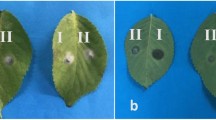Abstract
A disease caused by Alternaria alternata occurred on the leaves of European pear cultivar Le Lectier in Niigata Prefecture, Japan, and was named black spot of European pear. In conidial inoculation tests, the causal pathogen induced not only small black lesions on the leaves of European pear cultivar Le Lectier, but severe lesions on the leaves of apple cultivar Red Gold, which is susceptible to the A. alternata apple pathotype (previously called A. mali) causing Alternaria blotch of apple. Interestingly, the apple pathotype isolate showed the same pathogenicity as the European pear pathogen. HPLC analysis of the culture filtrates revealed that A. alternata causing black spot of European pear produced AM-toxin I, known as a host-specific toxin of the A. alternata apple pathotype. AM-toxin I induced veinal necrosis on leaves of Le Lectier and General Leclerc cultivars, both susceptible to the European pear pathogen, at 5 × 10−7 M and 10−6 M respectively, but did not affect leaves of resistant cultivars at 10−4 M. PCR analysis with primers that specifically amplify the AM-toxin synthetase gene detected the product of expected size in the pathogen. These results indicate that A. alternata causing black spot of European pear is identical to that causing Alternaria blotch of apple. This is the first report of European pear disease caused by the A. alternata apple pathotype. This study provides a multiplex PCR protocol, which could serve as a useful tool, for the epidemiological survey of these two diseases in European pear and apple orchards.




Similar content being viewed by others
References
Adachi, Y., & Tsuge, T. (1994). Coinfection by different isolates of Alternaria alternata in single black spot lesions of Japanese pear leaves. Phytopathology, 84, 447–451.
Akamatsu, H., Itoh, Y., Kodama, M., Otani, H., & Kohmoto, K. (1997). AAL-toxin-deficient mutants of Alternaria alternata tomato pathotype by restriction enzyme-mediated integration. Phytopathology, 87, 967–972.
Akimitsu, K., Tsuge, T., Kodama, M., Yamamoto, M., & Otani, H. (2014). Alternaria host-selective toxins: determinant factors of plant disease. Journal of General Plant Pathology, 80, 109–122.
Arie, T., Kaneko, I., Yoshida, T., Noguchi, M., Nomura, Y., & Yamaguchi, I. (2000). Mating-type genes from asexual phytopathogenic ascomycetes Fusarium oxysporum and Alternaria alternata. Molecular Plant-Microbe Interactions, 13, 1330–1339.
Egusa, M., Ozawa, R., Takabayashi, J., Otani, H., & Kodama, M. (2009). The jasmonate signaling pathway in tomato regulates susceptibility to a toxin-dependent necrotrophic pathogen. Planta, 229, 965–976.
Johnson, R. D., Johnson, L., Itoh, Y., Kodama, M., Otani, H., & Kohmoto, K. (2000a). Cloning and characterization of a cyclic peptide synthetase gene from Alternaria alternata apple pathotype whose product is involved in AM-toxin synthesis and pathogenicity. Molecular Plant-Microbe Interactions, 13, 742–763.
Johnson, R. D., Johnson, L., Kodama, M., Otani, H., Lane, C., Hughes, K., & Kohmoto, K. (2000b). A polymerase chain reaction-based method to specifically detect Alternaria alternata apple pathotype (A. mali), the causal agent of Alternaria blotch of apple from field isolates. Phytopathology, 90, 973–976.
Kohmoto, K., Taniguchi, T., & Nishimura, S. (1977). Correlation between the susceptibility of apple cultivars to Alternaria mali and their sensitivity to AM-toxin I. Annals of the Phytopathological Society of Japan, 43, 65–68.
Kohmoto, K., Otani, H., & Nishimura, S. (1982). Action sites of AM-toxins produced by the apple pathotype of Alternaria alternata. In Y. Asada, W. R. Bushnell, S. Ouchi, & C. P. Vance (Eds.), Plant infection: the physiological and biochemical basis (pp. 253–263). Tokyo: Japan Scientific Societies Press and Berlin: Springer-Verlag.
Kohmoto, K., Otani, H., & Tsuge, T. (1995). Alternaria alternata pathogens. In K. Kohmoto, U. S. Singh, & R. P. Singh (Eds.), Pathogenesis and host specificity in plant diseases: histopathological, biochemical, genetic and molecular basis, vol. 2 eukaryotes (pp. 51–63). Oxford: Pergamon.
Maeno, S., Kohmoto, K., Otani, H., & Nishimura, S. (1984). Different sensitivities among apple and pear cultivars to AM-toxin produced by Alternaria alternata apple pathotype. Journal of the Faculty of Agriculture, Tottori University, 19, 8–19.
Sambrook, J., Fritsch, E. F., & Maniatis, T. A. (1989). Molecular cloning: a laboratory manual (2nd ed.). Cold Spring Harbor: Cold Spring Harbor Laboratory.
Tanahashi, M., Yamaguchi, Y., Yokoyama, Y., & Otani, H. (2004). Black spot disease of European pear, a new disease caused by Alternaria alternata (Fries:Fries) Keissler. Japanese Journal of Phytopathology, 70, 168–175 (in Japanese with English Abstract).
Tsuge, T., Harimoto, Y., Akimitsu, K., Ohtani, K., Kodama, M., Akagi, Y., Egusa, M., Yamamoto, M., & Otani, H. (2013). Host-selective toxins produced by the plant pathogenic fungus Alternaria alternata. FEMS Microbiology Reviews, 37, 44–66.
Ueno, T., Nakashima, T., & Fukami, H. (1982). Chemical basis of host recognition by Alternaria species. In Y. Asada, W. R. Bushnell, S. Ouchi, & C. P. Vance (Eds.), Plant infection: the physiological and biochemical basis (pp. 235–251). Tokyo: Japan Scientific Societies Press and Berlin: Springer-Verlag.
Yoder, O. C. (1988). Cochliobolus heterostrophus, cause of southern corn leaf blight. Advances in Plant Pathology, 6, 93–112.
Acknowledgments
We thank Mr. T. Matsuda for his technical assistance. The authors also thank KN International, Inc. for the English language review.
Author information
Authors and Affiliations
Corresponding author
Rights and permissions
About this article
Cite this article
Tanahashi, M., Nakano, T., Akamatsu, H. et al. Alternaria alternata apple pathotype (A. mali) causes black spot of European pear. Eur J Plant Pathol 145, 787–795 (2016). https://doi.org/10.1007/s10658-016-0866-1
Accepted:
Published:
Issue Date:
DOI: https://doi.org/10.1007/s10658-016-0866-1




